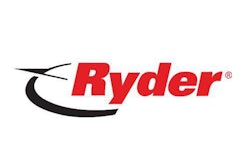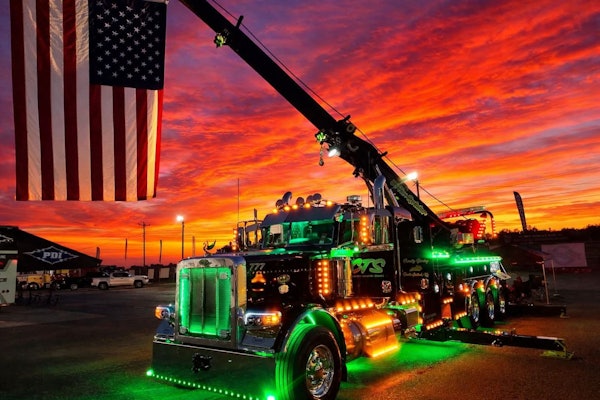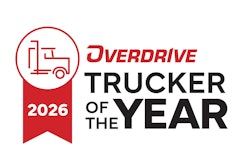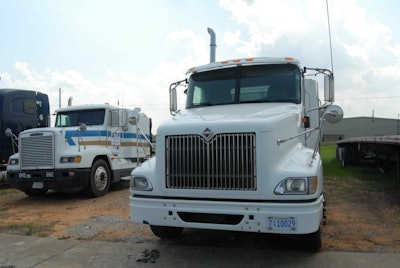
Financing a truck can be frustrating, confusing and time-consuming, especially for first-time buyers. It also can be costly if you are not prepared. The more deliberate you are about this process, the better your position. Give yourself plenty of time to shop for a truck and for favorable financing. Visit dealers and ask questions. Know what risk you present for a potential lender.
The good news is that truck loans, like business loans from a bank, usually have much lower rates than credit cards. Loans for trucks and other secured loans, such as cars or houses, are lowest because assets are backing them up. A bank’s business loan often is about 1 percent a month or 12 percent annually. That’s where the best credit card rates start, but they’re usually much higher, even 20 percent or more for owner-operators with bad credit ratings.
Get a copy of your credit report before you attempt to secure equipment financing. Your credit history could contain wrong or harmful information that you’ll want to explain to a potential lender. Always be upfront about your problems. Showing you have overcome hard times demonstrates determination and strong character. When you apply for a loan, be prepared to provide as much information as you can. The more you tell a potential lender about yourself and your operation, the more comfortable he will be lending you the money. Show the lender you are a business owner first and a truck operator second.

You’ll need a budget, a business plan and a cash-flow statement.
A detailed budget will assure the lender you can meet the financial obligations of owning a truck. A cash-flow statement shows your projected revenue will be sufficient to meet current obligations. A business plan outlines the details of your operation, including the types of freight you’ll haul, the traffic lanes you’ll run and the rate you’ll be paid. It also lists the name, address and telephone number of the company to which you plan to lease, as well as a contact name to verify that lease. If you plan to run independently, you’ll need to list contact information for your customers. Bring your lender a list of credit references, even if you don’t have a perfect credit history. Include present and past creditors.
FINANCING SOURCES
Banks are not your only option for borrowing money. Check around for the lender that best suits your needs.
Banks. Banks are reluctant to lend money for an over-the-road truck. In their opinion, “rolling collateral” is not a good risk. If you’ve been doing business at the same bank for a long time, however, and have an established relationship with a loan officer, it’s worth a try if your credit is good.
Captive Lending Institutions. These finance companies are owned by equipment manufacturers. They often are more willing than banks to lend money to new owner-operators because they are in the business of selling trucks.
Commercial Lending Instiutions. These finance companies are not necessarily affiliated with truck manufacturers, but certain ones cater to the trucking industry.
Used Truck Dealers. Your dealer may refer you to lenders other than captive finance arms.
Getting the Money. Whatever type of financing you choose, keep in mind that truck loan interest cost easily can consume up to 4 percent of your gross revenue. Interest rates can vary by two or three percentage points, even more – a potential difference of thousands of dollars in interest costs over the life of a loan.
No matter where you obtain financing, the following can affect your interest rate:
- Credit history. People who have good credit get the lowest interest rates.
- Stable job history. Job-hopping indicates a lack of responsibility and rings the alarm for a lender.
- Longtime residency. People who live at the same address for a long time usually have a better credit rating.
Don’t take the first financing option you’re offered. You can negotiate loan rates just as you can haggle over the price of a truck. Interest rates vary from lender to lender and from one part of the country to another, and finance managers have some leeway when setting the rate for your transaction.
TWEAKING THE LOAN
Some finance companies offer creative solutions for particular situations. These options include:
Variable rates. Most truck loans have a fixed interest rate, which means that you pay the same rate throughout the term of the loan. Sometimes you can get a variable rate. This usually is a good deal if the rate holds steady or drops, but if rates go up too much for too long, you might end up paying more than you would have under a fixed-rate loan.
More principal up front. With this option, your monthly interest charges and payments decline over time. Having lower payments in the latter part of the loan helps in two ways: It gives you more cash for truck maintenance as the truck ages, and it allows you to save for your next down payment as the time to trade approaches.
Skip-payment plan. Designed for truckers with seasonal freight, this plan allows you to miss a payment or two during slow times. You make the arrangements at the time of purchase. A variation is an extension of the first payment, say to 45 days, something many lenders are willing to do if your credit is strong.
Programs for buyers low on cash or credit. Some owner-operators without the cash for a big down payment or access to favorable loans have seen success buying in newer carrier sales programs for used fleet trucks. One carrier program has in recent years offered the opportunity to buy a truck with no money down and $99 payments for the first two months. Unlike a lease-purchase, buyers do not have to be affiliated with the carrier. Another has offered a one-year warranty program for about $2,500 bundled with the purchase of significantly older trucks and covering internally lubricated engine and transmission parts, injectors, piston rings and pins, drive axles, turbochargers and other components.
A shorter loan period. This means higher payments but big long-term savings in interest. If you’re used to 60-month loans — the owner-operators’ favorite — try to make a 48-month deal work.
NEGOTIATING THE DEAL
Getting a serviceable truck at the lowest payment possible is your goal. Before you head to the bargaining table, know how much you want to pay for a truck, how much you can manage per month and what interest rate you want. Then negotiate with what you consider to be the top three dealers. Never settle for the first quote. In many cases, you can work with a reputable dealer and bring down the price of your new rig through negotiation or specification changes.
If you’re buying a new truck, before negotiations begin ask each dealer to provide a complete breakdown of the vehicle price, showing the list price for the chassis and every spec option, applicable taxes, transportation and dealer prep costs. Ask about dealer add-ons, such as delivery charges and predelivery services, that could crop up after you cut the deal. Make sure your down payment or trade-in is included in the order.
Also, be sure your dealership is able to service your vehicle and that warranty work and downtime will have the least possible effect on your driving time and miles. Get warranty agreements in writing, and make sure you fully understand them. Find out whether warranty work can be done at any authorized shop in the nation and whether warranties cover labor, parts, towing, downtime and a replacement vehicle. Make sure you understand warranty coverage in terms of time and miles. Ask how warranty work is reimbursed.
BEFORE YOU SIGN
Get full disclosure before you sign a finance contract. Make sure the total price is defined clearly. Truth-in-lending laws do not apply to commercial loans such as truck financing, so dealers do not have to give full disclosure, but most will if they are asked.
In addition:
- Don’t sign anything you don’t understand.
- Get a copy of everything you sign.
- When trading, don’t sign over the title of your truck until you take delivery of the truck you’re buying.
- Don’t sign a finance contract until you have a ready source of revenue. Make sure you can put your truck to work within a few days of leaving the lot.
- Don’t automatically include insurance in the final contract. Shop around beforehand, and you might opt to buy it elsewhere.
- Don’t sign up automatically for credit life or credit disability insurance, which covers your truck payments if you die or become disabled. You likely can get the same type of policy on your own at a much lower rate.
- Make sure all requested repairs are completed to your satisfaction.
CLEANING YOUR CREDIT
Bad credit adds tens of thousands of dollars to the price of a truck or a house by increasing the cost of borrowing money – assuming the would-be borrower can find a lender at all. Since the late-2008 credit crunch, lending terms have tightened considerably, so having good credit is even more important.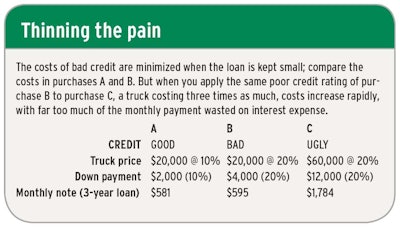
An owner-operator with bad credit may get turned down by the fleet to which he hoped to lease. He may get turned down by a government agency when he applies for a loan to purchase a low-cost anti-idling kit. Lucrative military or otherwise sensitive freight might never go onto his truck because the Pentagon or other shippers don’t consider him a good risk.
Keep in mind that for a self-employed person like an owner-operator, personal credit and business credit are indistinguishable. Self-employed people sometimes want to show a loss at year’s end for tax purposes, but that negative net income looks bad to a lender.
When you seek financing from a truck manufacturer, your local bank or the Small Business Administration, you can try to make clear to the loan officer the distinction between your business finances and your personal finances. Credit bureaus, however, don’t make that distinction; they just crunch the numbers.
Here’s how your credit score is calculated:
- Your payment history: 35 percent.
- Outstanding debt: 30 percent.
- The length of your credit history: 15 percent.
- The types of credit you use: 10 percent.
- The new credit you request: 10 percent.
The good news is that even the worst credit situation can be improved. As little as two or three years of good payment behavior can make a positive difference in your credit score, which assigns more weight to recent acts than to older ones. In the meantime, lenders are out there for truck buyers even with C-level and D-level credit, especially in the used-truck market. And certain carriers always are looking to groom owner-operators, providing bookkeeping and business advice to help those clients succeed.
In the general lending market, those with a credit score in the low 600s probably can find a lender but likely will have to put down 20 percent or more as opposed to the traditional 10 or 15 percent. Buyers with a credit score in the 500s, on the other hand, may be out of luck – at least temporarily. The Used Truck Association recommends this three-step process for climbing out of a bad-credit hole:
- Be willing to start with a cheap used truck (and a strong maintenance savings plan).
- Bite the bullet on interest rates. You may pay 18 or 20 percent interest, but on a $20,000 truck, that means only an extra $30 to $40 a month. (See the chart).
- Work on improving your credit rating and qualifying to refinance the loan at a better rate in a year or two.
There are many ways to improve your credit rating, though it takes time. The obvious ones include:
- If you’re in arrears on any accounts, pay what you owe – including penalties – as fast as possible, even if it means living off Ramen noodles.
- Pay bills, including all personal bills, on time. Often this means making a business budget and a household budget and sticking to them.
- Reduce your credit card balances. The ideal is to pay off each one monthly to avoid interest, but even if you can’t manage that just yet, pay them down until each balance is no more than half the card limit.
- Consolidating your credit card debt onto one card can be worthwhile, but only if you can find a card that will enable you to do that without costing you more in the long run. MyFICO.com offers a free online calculator that can show you whether such an offer really is a good deal.
- Avoid signing up for new cards. The average American makes fewer than two credit applications a year, so if you do even three in a given year, you’re hurting your credit score. Your ideal ratio should be one credit card for each installment loan, up to five cards. That means your truck loan “earns” you one credit card, your mortgage a second credit card and so on.
- On the other hand, if you have an old credit card that you barely use anymore, don’t be too quick to close it out. Its mere existence provides a boost to your credit score, 15 percent of which depends on the length of your credit history – or, in other words, how long you’ve been someone’s good customer.
- Don’t co-sign a loan, even if you’re trying to help out a close friend or relative. In many states, if the primary borrower misses payments, the creditors can turn to the co-signer for satisfaction. You could lose your truck – even your house.
- Use what you save. Once you’re current on your truck and mortgage payments and have paid off your credit card debt, you’ll have extra money each month that’s no longer being spent on interest and penalties. Put this “found money” into your emergency fund or your retirement savings, or invest it.
Qualifying for a good rate
Big contributing factors to interest rates are how much you put down, the type of truck you buy, your credit score and your loan-to-truck value ratio.
For owner-operators with good credit and who have a sizable down payment, local banks sometimes can offer rates at or below 10 percent. Those with credit issues could see rates as high as 28 percent.
Though some owner-operators may find it difficult to get financing, lenders today are much more willing to work with used truck buyers than in recent, tougher years. The upturn in freight over the past three to four years and the more recent boost in rates have brought many lenders back into the business. Freight’s available, rates are good and carriers are giving owner-operators ample opportunity to haul. While the price of trucks is high, the ability to make an economic return with that investment is there. At the same time, high-mileage trucks make lenders more hesitant, and they do want decent down payments, often around 20 percent. With a credit score of 600 or better, buyers can land a 600,000-mile truck with a 20 percent down payment financed for two to three years at 12 to 15 percent.
First-time buyers could see interest rates about 18 to 20 percent, and first-time buyers and buyers with credit problems should be wary of service charges that could add $1,000 or more to monthly payments.
Many lenders are looking past credit scores to “dig deeper” into buyers’ credit profiles in today’s market. Yearly earnings, business longevity, how long you’ve had a commercial driver’s license, a recent home foreclosure or truck repossession, and items that show up on public records all have a bearing on your financing potential.
Meeting debt obligations and saving for a 25 percent down payment should open the door for a first-time buyer’s financing. Those buyers also do well if they have three to four accident-free years in trucking.

